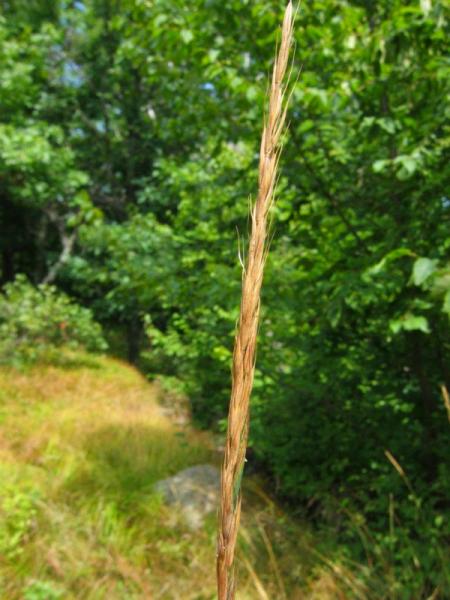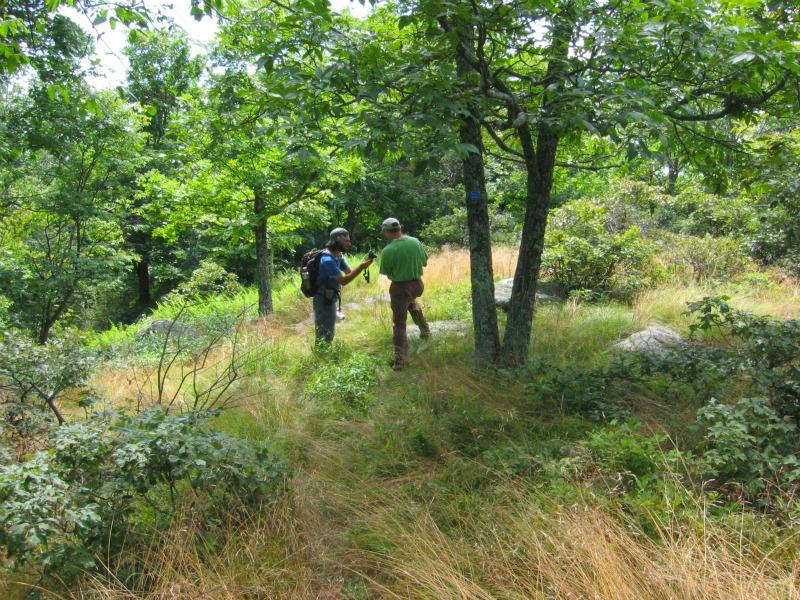Blue Wild Rye
Elymus glaucus ssp. glaucus None
- Class
- Monocotyledoneae (Monocots)
- Family
- Poaceae (Grass Family)
- State Protection
- Endangered
Listed as Endangered by New York State: in imminent danger of extirpation in New York. For animals, taking, importation, transportation, or possession is prohibited, except under license or permit. For plants, removal or damage without the consent of the landowner is prohibited.
- Federal Protection
- Not Listed
- State Conservation Status Rank
- SNA
Not Applicable - A state conservation status rank is not applicable because the species is not a suitable target for conservation activities (e.g., species is a hybrid, a domesticated species, not native to New York, an accidental or infrequent visitor outside of its normal range, a transient or migrant just passing through the state, or a species with only unconfirmed or doubtful reports).
- Global Conservation Status Rank
- G5T5
Secure globally - Both the species as a whole and the subspecies/variety are common in the world; widespread and abundant (but may be rare in some parts of its range).
Summary
Did you know?
Blue Wild Rye is native to only one New York county (Sullivan). New York marks the eastern edge of its range, which in the west extends from Alaska to Texas. Its common name refers the leaves and spikelets, which may sometimes be purplish or bluish.
State Ranking Justification
There is only one known, native population of this species in New York.
Short-term Trends
This one native population of this species in the state was first discovered in 2006, and found to be persisting in 2007.
Long-term Trends
The long-term trends of this species recently discovered in New York are unknown.
Conservation and Management
Threats
There are no known immediate threats to the single population of this species in New York.
Conservation Strategies and Management Practices
No management needs are apparent.
Research Needs
Inventory and research should focus on whether this newly-documented species is as rare in the state as it appears to be, and if so, why.
Habitat
Habitat
The site where Elymus glaucus ssp. glaucus occurs in New York is a pitch pine oak heath rocky summit natural community. The plants occur near the top of an east-facing ridge, between 1700 and 1800 feet in elevation. There are areas of oak and pine forest as well as ledges and rocky outcrops dominated by grasses and sedges (New York Natural Heritage Program 2009).
Associated Ecological Communities
- Pitch pine-oak-heath rocky summit
(guide)
A community that occurs on warm, dry, rocky ridgetops and summits where the bedrock is non-calcareous (such as quartzite, sandstone, or schist), and the soils are more or less acidic. This community is broadly defined and includes examples that may lack pines and are dominated by scrub oak and/or heath shrubs apparently related to fire regime.
- Pitch pine-oak-heath woodland*
(guide)
A pine barrens community that occurs on well-drained, infertile, sandy soils. The structure of this community is intermediate between a shrub-savanna and a woodland. Pitch pine and white oak are the most abundant trees.
* probable association but not confirmed.
Associated Species
- Carex argyrantha (silvery-green sedge)
- Carex lucorum (long-beaked carpet sedge)
- Carya glabra (pignut hickory)
- Corydalis sempervirens
- Dennstaedtia punctilobula (hay-scented fern)
- Deschampsia flexuosa
- Quercus alba (white oak)
- Quercus ilicifolia (scrub oak, bear oak)
- Quercus rubra (northern red oak)
- Schizachyrium scoparium
- Vaccinium pallidum (hillside blueberry)
Range
New York State Distribution
The only known native population of this grass in New York is located in Sullivan County.
Global Distribution
Elymus glaucus spp. glaucus ranges from Alaska to Saskatchewan in the northwest south through the mountains of the western United States, extending to Baja California and New Mexico. It is also found sporadically further east, from the northern Great Plains to southern Ontario, Michigan, and New York.
Identification Comments
General Description
Blue Wild Rye is a perennial grass which grows in clumps 30 to 140 cm tall, occasionally spreading by underground stems (rhizomes). The leaf blades are 10 to 17 mm wide and usually without hairs. The erect stems are topped by a spike (inflorescence), 5 to 12 cm long and 5 to 15 mm wide. As in all grasses, the small, inconspicuous flowers occur in scaly structures called spikelets. Elymus glaucus ssp. glaucus usually has 2 spikelets per node and internodes 4 to 8 mm long. Each spikelet has 2 to 4 florets, each with awns projecting 10 to 25 mm from one of the scales (the lemma) (FNA 2008).
Best Life Stage for Proper Identification
Fruiting individuals are needed for positive identification.
Similar Species
Elymus glaucus is unique among the Elymus species of eastern North America for having glumes (the bracts at the base of each spikelet) with hyaline (thin and translucent), overlapping margins. In New York, it is most similar to E. riparius, E. villosus, and E. virginicus. In addition to having hyaline-edged glumes, it differs from these species by having fewer (6 to 7) stem leaves than do E. riparius (9 to10), or E. virginicus ( 7 to 10), and having longer (7.5 to 10.5 mm long) paleas than does E. villosus (5.5 to 6.7 mm long). Elymus glaucus ssp. glaucus is the only subspecies of E. glaucus which occurs in New York (FNA 2007, Voss 1972).
Best Time to See
The best time to see this plant is when it is fruiting, from mid-July through October.
- Fruiting
The time of year you would expect to find Blue Wild Rye fruiting in New York.
Blue Wild Rye Images
Taxonomy
Blue Wild Rye
Elymus glaucus ssp. glaucus None
- Kingdom Plantae
- Phylum Anthophyta
- Class Monocotyledoneae
(Monocots)
- Order Cyperales
- Family Poaceae (Grass Family)
- Order Cyperales
- Class Monocotyledoneae
(Monocots)
- Phylum Anthophyta
Additional Resources
Best Identification Reference
Flora of North America Editorial Committee. 2007. Flora of North America, North of Mexico. Volume 24. Magnoliophyta: Commelinidae (in part): Poaceae, part 1. Oxford University Press, New York. 911 pp.
Other References
Fernald, M.L. 1970. Gray's manual of botany. 8th edition. 1970 printing with corrections by R.C. Rollins [of 1950 8th edition]. D. Van Nostrand Company, New York.
Gleason, H.A., and A. Cronquist. 1991. Manual of vascular plants of northeastern United States and adjacent Canada. New York Botanical Garden, Bronx, New York. 910 pp.
Gleason, Henry A. and A. Cronquist. 1991. Manual of Vascular Plants of Northeastern United States and Adjacent Canada. The New York Botanical Garden, Bronx, New York. 910 pp.
Hitchcock, A. S., and A. Chase. 1971. Manual of the grasses of the United States. Second edition. Dover Publications, New York. 2 volumes. 1051 pp.
Holmgren, Noel. 1998. The Illustrated Companion to Gleason and Cronquist's Manual. Illustrations of the Vascular Plants of Northeastern United States and Adjacent Canada. The New York Botanical Garden, Bronx, New York.
Mitchell, Richard S. and Gordon C. Tucker. 1997. Revised Checklist of New York State Plants. Contributions to a Flora of New York State. Checklist IV. Bulletin No. 490. New York State Museum. Albany, NY. 400 pp.
New York Natural Heritage Program. 2010. Biotics database. New York Natural Heritage Program. New York State Department of Environmental Conservation. Albany, NY.
New York Natural Heritage Program. 2024. New York Natural Heritage Program Databases. Albany, NY.
Reschke, Carol. 1990. Ecological communities of New York State. New York Natural Heritage Program, New York State Department of Environmental Conservation. Latham, NY. 96 pp. plus xi.
Voss, E.G. 1972. Michigan flora: A guide to the identification and occurrence of the native and naturalized seed-plants of the state. Part I. Gymnosperms and monocots. Cranbrook Institute of Science and Univ. Michigan Herbarium. Ann Arbor. 488 pp.
Weldy, T. and D. Werier. 2010. New York flora atlas. [S.M. Landry, K.N. Campbell, and L.D. Mabe (original application development), Florida Center for Community Design and Research http://www.fccdr.usf.edu/. University of South Florida http://www.usf.edu/]. New York Flora Association http://newyork.plantatlas.usf.edu/, Albany, New York
Weldy, Troy W. and David Werier. 2009. New York Flora Atlas. [S.M. Landry and K.N. Campbell (original application development), Florida Center for Community Design and Research. University of South Florida]. New York Flora Association, Albany, NY. Available on the web at (http://www.newyork.plantatlas.usf.edu/).
Werier, David. 2017. Catalogue of the vascular plants of New York State. Memoirs of the Torrey Botanical Society. Volume 27. The Torrey Botanical Society. The New York Botanical Society, Bronx, NY 10458. 542 pages.
Links
About This Guide
Information for this guide was last updated on: March 9, 2009
Please cite this page as:
New York Natural Heritage Program. 2024.
Online Conservation Guide for
Elymus glaucus ssp. glaucus.
Available from: https://guides.nynhp.org/blue-wild-rye/.
Accessed July 27, 2024.

